In the time and place where I grew up—Sioux City, Iowa, in the 1960s and early ‘70s—hunting dog breeds didn’t live in the house, period. It simply wasn’t done. The proper place for a bird hunting dog was in an outside kennel, typically a cyclone-fenced enclosure attached to a garage or, less frequently, some sort of freestanding unit with a “dog house” for shelter.
This was waterfowling
and pheasant-hunting
country; breed-wise, you rarely saw anything except Labrador retrievers, German shorthaired pointers, and Brittanys, in those days still called Brittany spaniels. My parents bought me an Irish setter when I was 13 (I’d been ruinously influenced by Jim Kjelgaard’s Big Red series), but while Sheila never panned out as a hunter she lived outside, too.
The presumption was that living in the house would make a dog “soft”—as if constant exposure to the elements was a prerequisite to maintaining hunting ability. There was never a shred of evidence to support this but received wisdom dies hard, especially in the dog camp. If a bird hunting dog kept inside got soft, it was the kind of softness of the flesh that comes from being overfed and underexercised, not some mysterious erosion of the desire to point, flush, and/or retrieve birds.
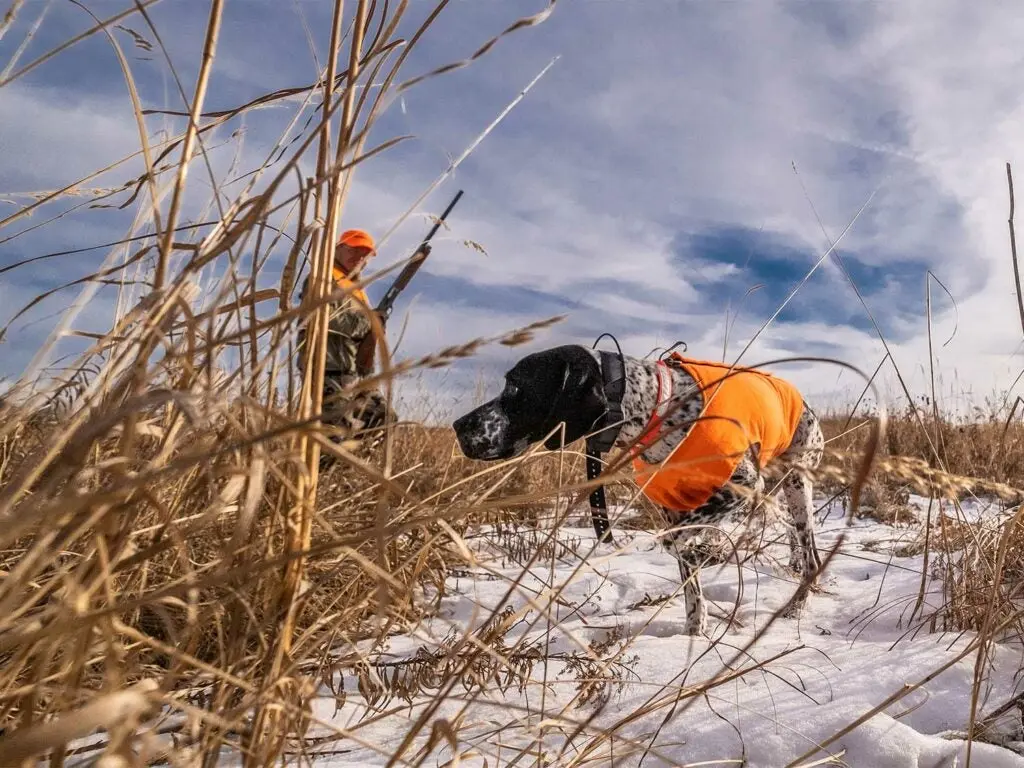
Spending time with your dog both in the field and at home will form a strong bond. Federal Ammunition
Probably the best reason for keeping dogs in outside kennels, historically, was to prevent the spread of external parasites such as fleas and the mites that cause sarcoptic mange (scabies in humans). But in these days of incredibly effective preventatives, that risk has largely, if not entirely, disappeared.
The upshot being that in 2021 there’s no reason whatsoever why your four-legged hunting partner can’t, or shouldn’t, live in the house. As long as it works within the context of your particular family dynamic, it’s really a win-win. The more time you spend with your dog, the stronger your bond will become
, making him more biddable, attentive, and eager-to-please in the field. If you have children at home, helping to care for a dog will teach them important lessons about responsibility and empathy; it’s also been shown that kids who have a dog in the house get significantly more exercise than their dogless peers—not a small thing in this era of rampant childhood obesity. For that matter, adults who live with dogs typically get more exercise, too.
Like I said, win-win.
It goes without saying, of course, that your choice of a breed will depend on a variety of factors, including what, where, and how you like to hunt, where you live, and so on. But if you’re looking for a productive hunting dog
that can pull double-duty as a house dog and family companion, here are several breeds especially well-suited to the task.
Best Hunting Dog Breeds: Flushing/Retrieving Dogs
1. Labrador Retriever

Labrador retrievers can do just about any job in the field. Image by Gerd Maiss from Pixabay
There’s a reason that, year-in and year-out, the Lab stands atop the list of purebred dogs registered with the American Kennel Club. On second thought, that’s not quite right. There are a host of reasons. Labs are intelligent, highly trainable, even-tempered, eager-to-please, great with kids, fun to be around, and, on top of everything else, tremendous workers both in water and on land. As someone observed, they’re the Swiss Army Knife of gundogs, capable of handling just about any flushing or retrieving task that’s presented to them. They’re terrific shed hunters, too. Like all the sporting breeds, Labs have been selectively bred over many generations to partner with humans in the performance of complex, mutually rewarding tasks, making them genetically predisposed—hard-wired, if you will—to be “people dogs.” They also have a unique low fear/low aggression personality profile, which explains why Labs make outstanding hunters and service dogs but, as a rule, lousy guard dogs. If there’s one caveat to living with a Lab, it’s that you have to be brutally vigilant about maintaining portion control and not overfeeding
. Labs are voracious eaters, and because they tend to finish off their food in about the time it takes to pour it into the bowl it can be hard to convince yourself that they’re getting enough. You have to be strong and let body condition, not the quantity of food (or the rapidity of its consumption) be your guide in this respect.
2. Golden Retriever

The coat on a golden retriever will require a little upkeep, but they are tenacious hunters. Image by Wolfgang Horvath from Pixabay
For almost as long as the Lab has been the top dog in terms of AKC registrations, the golden’s had a lock on the #3 spot
. (The second most popular breed, for the record, is the German shepherd.) The golden brings a lot of the same qualities to the table that the Lab does, but if anything, he’s even more affectionate and fun-loving. Think of it this way: You’d want a Labrador to handle your money, but you’d want a golden to throw you a party. A couple of hours into the festivities, he’d be the one wearing the lampshade. Make no mistake, though: This dog hunts. Or at least he does if he comes from solid field stock. The rule of thumb in this respect being that you don’t want the kind of fashion-model goldens you see emerging from Manhattan high-rises or mansions in Beverly Hills; you want their country cousins. The golden’s luxurious coat requires a fair bit of upkeep, and if you hunt pheasants with a golden—a job the breed typically excels at—you’d better be prepared to comb out some burs. One thing to be aware of, if the golden is on your shortlist, is that the breed has a propensity for developing certain cancers. The risk is especially high for spayed females, leading an increasing number of veterinarians to recommend that female goldens not be spayed unless there’s a compelling medical reason for doing so. It’s something to think about.
Read Next: The 10 Best Gun Dogs for Ruffed Grouse Hunting
Best Hunting Dog Breeds: Pointing Dogs
3. German Shorthaired Pointer
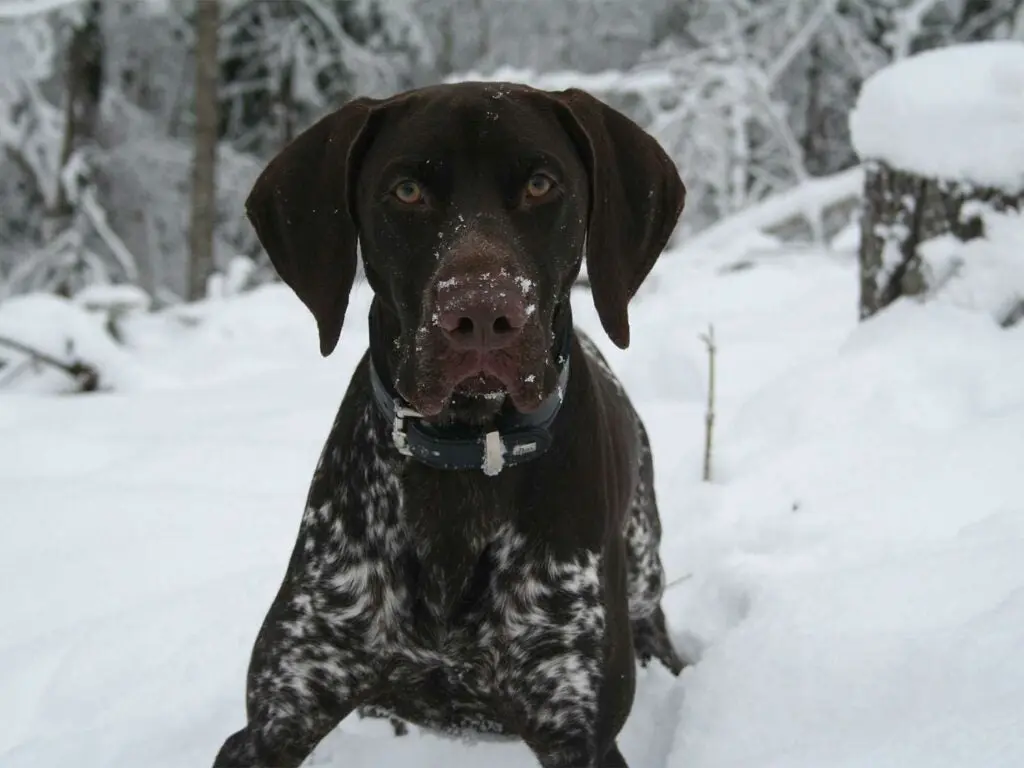
The ever-popular German shorthaired pointer excels at just about any upland hunting task. Image by majohn67 from Pixabay
Another hunting dog breed that ranks consistently high on the AKC’s “most popular” list, the German shorthair is a rugged, handsome, all-purpose hunter
that’s proven itself on every upland gamebird, under every conceivable condition, in all parts of the country. A natural retriever, the shorthair can also handle light- to medium-duty water work, although if he’s going to get wet you’ll want to outfit him with a neoprene vest for additional warmth. Beneath their stoic Teutonic veneer, GSPs are actually very loving dogs; it’s just that they’re not as gushily demonstrative about it as some other breeds. They have the virtue of being about as undemanding and low-maintenance as a dog can be; plus, they have a well-developed on-off switch, meaning that they transition easily from being all-business in the field to being all-chill at home. They’re great with kids, too. Along with other taller, deeper-chested breeds, GSPs can be susceptible to bloat and gastric torsion—related, incompletely understood conditions that always demand immediate veterinary intervention. Beyond that, it’s awfully hard to think of anything about the German shorthair that’s not to like.
**Read Next: 11 Legendary Hunting Dogs
**
4. Brittany
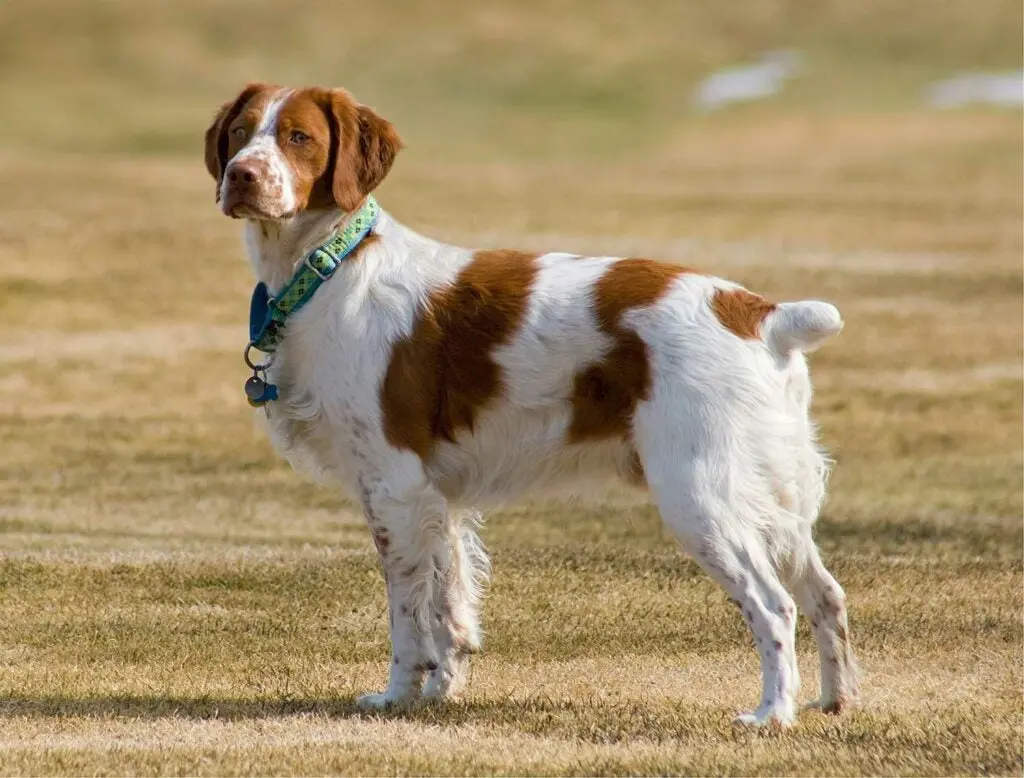
Brittany’s look more like house dogs than gun dogs, but they’re excellent upland hunters. Image by 272447 from Pixabay
If any hunting dog breed looks like it belongs in the house, it’s the Brittany. (And yes, “Brittany” is the breed’s full name; the spaniel designation was dropped several decades ago.) To look at a Britt, you’d think he was just a fuzzy, friendly, stub-tailed, somewhat overgrown lap dog—which, as it happens, is exactly the impression the French farmers and assorted countrymen who developed the breed hoped it would convey. A lot of them moonlighted as poachers, and while being seen with a pointer or setter would have aroused suspicion, a Brittany, which brought to mind a mutt that had somehow lost its tail, could operate under-the-radar. Plus, if a poacher was surprised by one of the Count’s bailiffs, he could literally tuck his 30-pound dog under his arm and make a run for it. (I’m not making that up.) Prized by American sportsmen for its versatility, biddability, and palpable joie de vivre, the Britt first caught on among Midwestern pheasant hunters but soon, thanks in large part to the efforts of legendary professional trainer Delmar Smith, gained a following among quail hunters in Texas and Oklahoma as well. Britts can be a little on the quirky, hard-to-read side—you sometimes find yourself wondering what the heck they’re thinking—but by and large, they’re wonderful, easy-going companions who thrive in a family environment. Their smallish size makes them particularly well-suited to apartment living, too.
5. English Setter
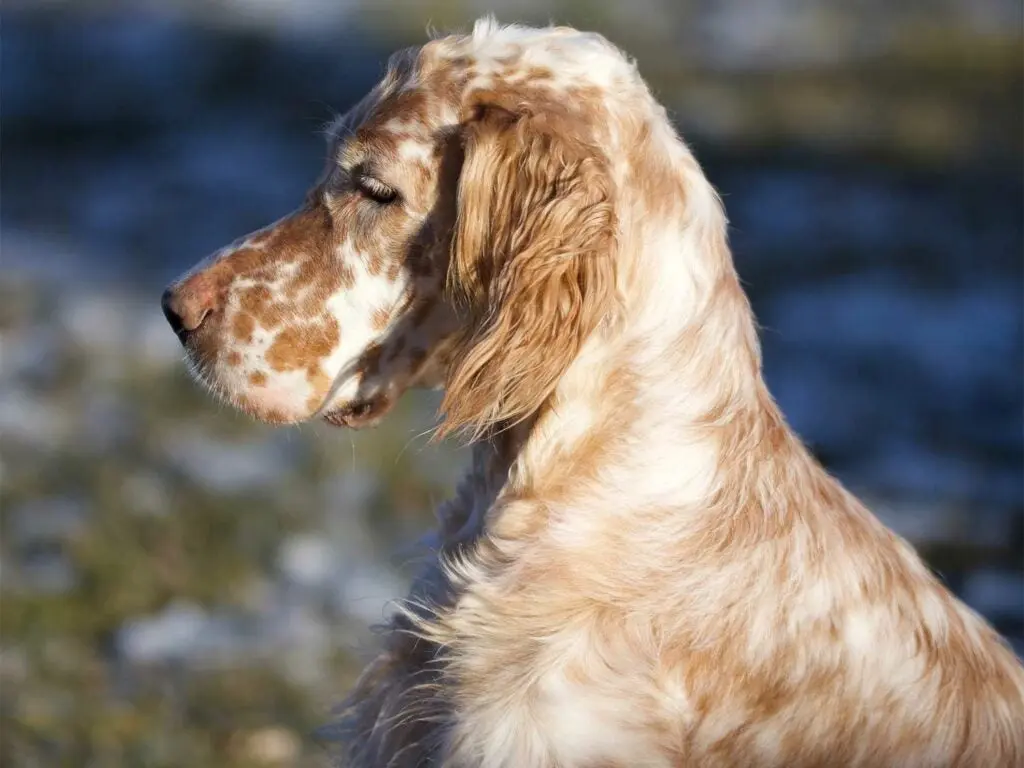
English setters may be the most handsome hunting dogs there are. Image by Nicki5623 from Pixabay
The aristocracy of the canine race, the English setter is the dog most of us see sprawled in front of the hearth when we imagine a classic post-hunt scene: roaring fire, leather-bound book, comfortable chair, ice cubes tinkling in a glass of brown liquor. It’s hard for me to be objective here—I’ve always considered myself a Setter Man first and foremost—but those who maintain that a good English setter will spoil you for any other breed will get no argument from me. There’s the beauty and functionality, of course, the incomparable style, but there’s also an aura of romance to the setter that no other hunting dog breed can match. From a practical perspective you need to be aware that, depending on the bloodline, one English setter can look so different from another that it can be hard to wrap your mind around the idea that they’re the same breed. There are 80-pound setters with silky coats that nearly brush the ground, and there are 35-pound setters with just enough wispy feathering to distinguish them from pointers. And while the bigger individuals tend to be slow, methodical, and close-working, some of the smaller setters cover so much ground, so fast, that they all but leave a contrail. The good news is that regardless of size or type, they all share the elegantly refined personality—to the manner born, as they say—that makes the English setter beloved.
Read Next: How to Choose Your First Bird-Dog Puppy
6. Pointer
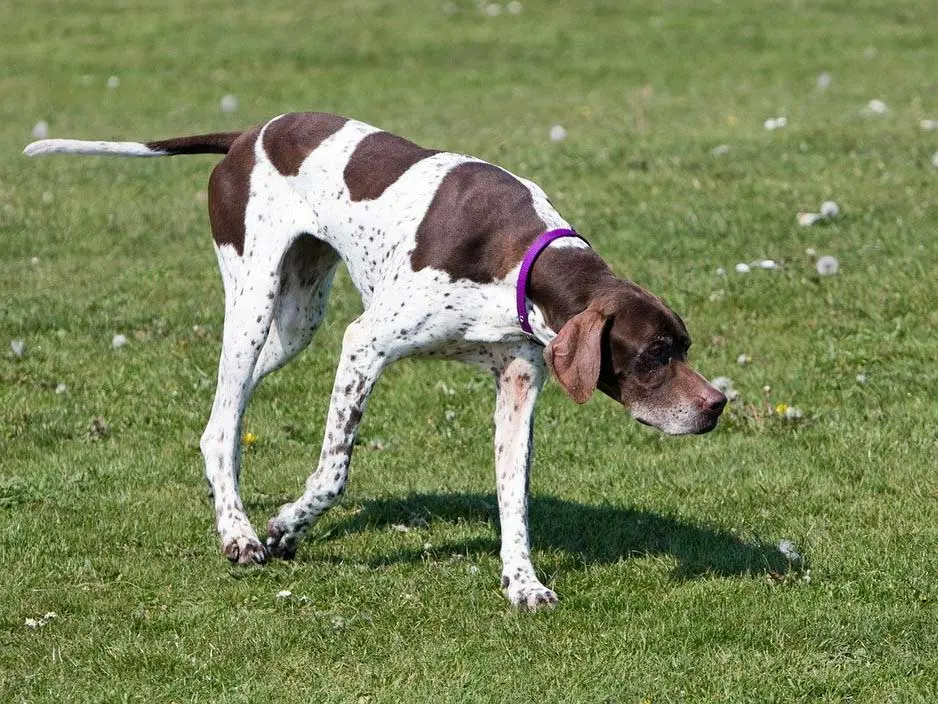
If you think that pointers don’t belong in the house, you’d be wrong. Image by Karen Arnold from Pixabay
If there’s a hunting dog breed on this list that you probably didn’t see coming, the pointer is it. (And yes, the name of the breed is pointer; “English pointer” is a misnomer.) Stereotypically aloof, unaffectionate, and so ferociously single-focused on its mission of finding birds that it doesn’t give a flying you-know-what about anything else—with the possible exception of eating and, ahem, that other thing—the pointer is a dog that, in the minds of most sportsmen, not only lives in a kennel but belongs there. Well, bollocks. This is a self-fulfilling prophecy, pure and simple. Do pointers get along fine in kennels? Absolutely—but that doesn’t mean they don’t make great house dogs. The most affectionate dog I’ve ever owned was a pointer, and my friend Steve Smith, the eminent editor, author, and wingshooting authority, has kept his pointers in the house for years. When I asked him about it he said, “At the moment two pointers are keeping my family-room couch from floating away. Later they will rouse themselves to beg at the table—successfully—after which they’ll spend the night on their pads in the bedroom. Does this affect their hunting? Yes—they’re more in tune with me because they’re with me pretty much 24/7.”
The preceding list is by no means exhaustive. The bristly appearance of the wirehaired pointing griffon, for example, belies as sweet as disposition as you’ll ever find. The griff soaks up attention like a sponge, gives as good as it gets, and is a great choice for the hunter who wants both a family companion and a close-working, easy-handling pointing dog that retrieves naturally and is about as weatherproof as a pointing breed can be.
Then there are the lookalike spaniels who share the distinction of being Official State Dogs: the American water spaniel (the state dog of Wisconsin) and the Boykin spaniel (the state dog of South Carolina). They flush and retrieve upland birds and waterfowl, yes, but they’ll also scatter turkeys, tree squirrels, run rabbits, even, if given the opportunity, catch the occasional mink or muskrat. They’re a little more in the “one man dog” mold than some of the other hunting dog breeds we’ve mentioned, but that’s not necessarily a bad thing.
![Field & Stream [dev]](https://images.ctfassets.net/fbkgl98xrr9f/1GnddAVcyeew2hQvUmrFpw/e4ca91baa53a1ecd66f76b1ef472932b/mob-logo.svg)





